TAPI Case Opening Steps
For development issues and questions that cannot be addressed through the forum, you can open a case with Cisco's Developer Support team.
For Solution Partner Program partners, this service is included in your Solution Partner Program memberships. You can also purchase tickets as needed basis directly from the site.
To help resolve your case quickly, please provide the following information when opening a developer support case:
- General description of the problem
- Is the problem reproducible or intermittent?
- Device Names, Directory Names (DN's)
- Observed vs. expected API behavior
- Version Number of CUCM
- Version Number of TAPI
- Version of Windows
- Dr.Watson Logs (In case of a TSP crash)
- TAPI Logs ( Gathering detailed level TAPI Traces)
- Cisco CTI/Call Manager Traces( Gathering CTI/CM (SDI/SDL) Traces )
- Time Stamp of the Issue
Gathering detailed level TAPI traces
Below are the steps to gather detailed TAPI traces
- Step 1:
Login to the server that is running your application. Choose Start > Settings > Control Panel and select Phone and Modem Options. - Step 2:
Click Advanced tab and select the CiscoTSP 0xx and click Configure button. You should see a window like below:
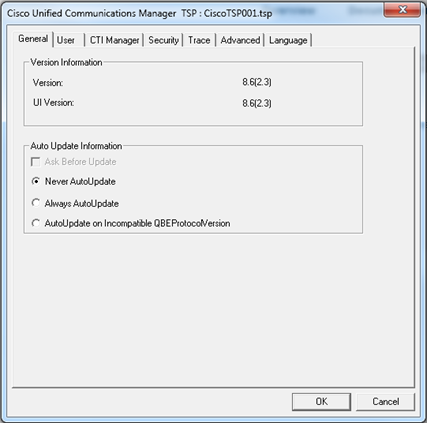
- Step 3: Click the Trace tab. Select Trace On check box and
- Check the "TSP Trace" to trace the TSP internal messages. Select Detailed to log internal messages for debugging purposes.
- Check the "CTI Trace" to trace the messages sent between CTI and TSP.
- Check the "TSPI Trace" to trace the requests and events that are sent between TSP
and TAPI.

- Step 4:
Set up a Directory that is the path for the trace log. For example, c:\Temp No. of Files: Setting this to a value greater than or equal to 1 enables rolling log files. For example, a value of 10 will cause up to 10 log files to be used in a cyclic fashion. Max lines/file: specifies the maximum number of trace statements that will be written to each log file. For example, a value of 1000 will cause up to 1000 trace statements to be written to each log file.
After setting these options, you will need to restart the machine or follow these steps for the settings to take effect.
- Stop all TAPI applications.
- Stop the "Telephony" service (However, this is dependent on stopping the "Remote Access Connection Manager" service if it is running and Microsoft does not allow this service to be stopped in most Windows OS).
- Restart the TAPI application (notice that you don't need to start the "Telephony" service since starting the 1st TAPI application restarts this service).
Because of step #2, it would be easier to reboot the machine.
Gathering CTI/CM (SDI/SDL) Traces
- Please Enable the following on Call Manager Side to collect CTI-SDI traces:
- From CCM Serviceabitliy page, go to CM Services/Cisco CTIManager(Active)
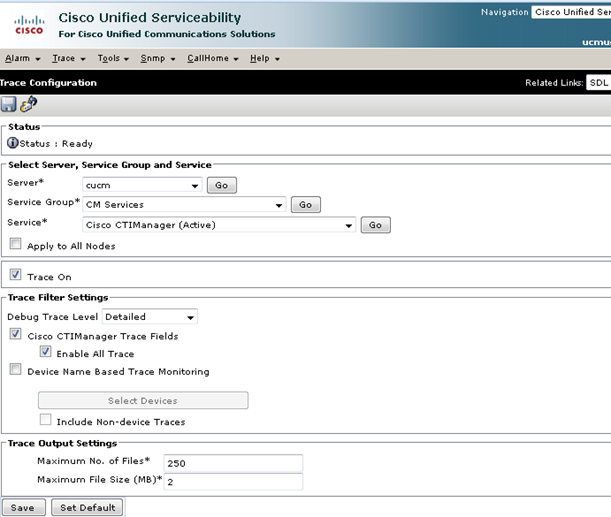
- Check the trace output Settings, if there is a large amount of traffic, you may need to increase the number and/or size of the files to ensure they are nor overwritten too quickly. For this purpose leaving this column default is fine.
- Select SDL Configurations in "Related Links".

- Check the trace output settings as shown below to collect the CTI-SDL traces.
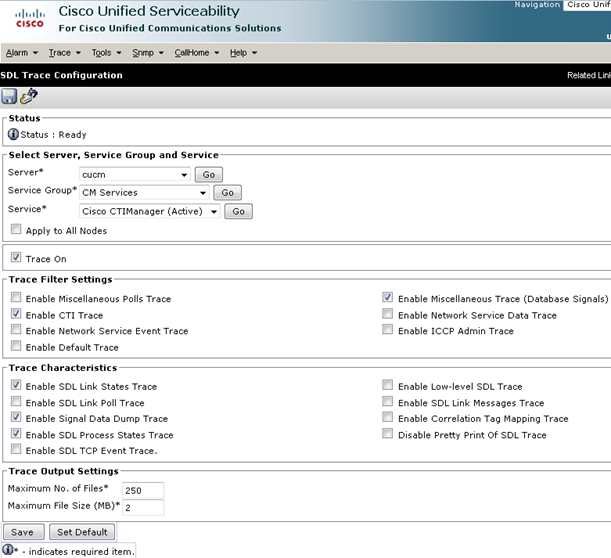
- From CCM Serviceabitliy page, go to CM Services/Cisco CTIManager(Active)
- Please Enable the following on Call Manager Side to collect CCM-SDI traces:
- From CCM Serviciability page, go to CM Services/CiscoCallManager(Active)
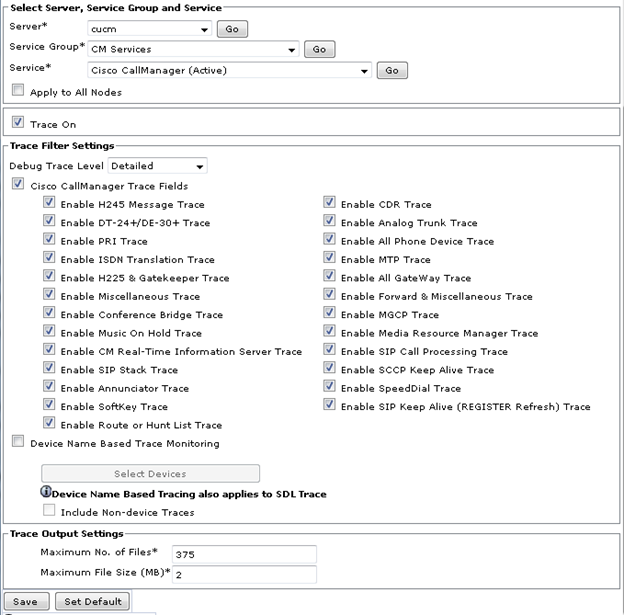
- Check the trace output Settings, if there is a large amount of traffic, you may need to increase the number and/or size of the files to ensure they are nor overwritten too quickly. For this purpose leaving this column default is fine.
- Select SDL Configurations from "Related Links" and check the trace output settings
as shown below to collect the CCM-SDL traces.
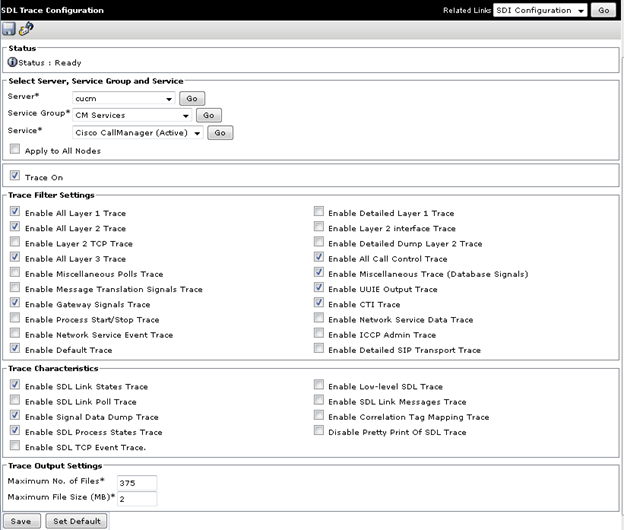
- From CCM Serviciability page, go to CM Services/CiscoCallManager(Active)
- Run the test (The application you want to test or which is creating the issue).
- Collect the CCM/CTI (SDI/SDL) traces using (Real-Time Monitoring Tool) RTMT. If you don't have RTMT, Download it from the Call Manager Admin Page. Go to -> Application -> Plugins -> Cisco Unified Real-Time Monitoring Tool.
- To collect traces using RTMT, connect to CM and select "Trace&Log Central" and/or
double click on "Collect files". In the window that opens, select all the servers for
Cisco CTIManager & Cisco CallManager

- Click "Next" and "Next" again to get to "Collect File Options". In the "Collection Time" section, Select an Absolute range approximately 30 minutes before and after your test run. In the "Download File Options" select the required option. To zip the files is a convenient option.
- Please e-mail or attach these files to your case using the on line TAC case tool.







